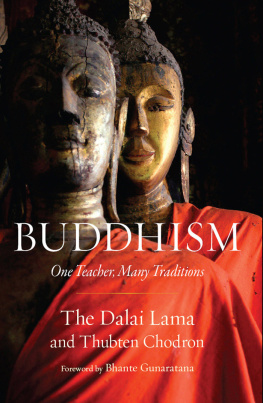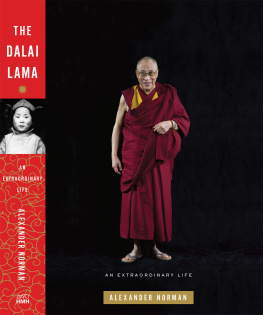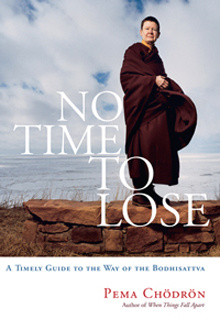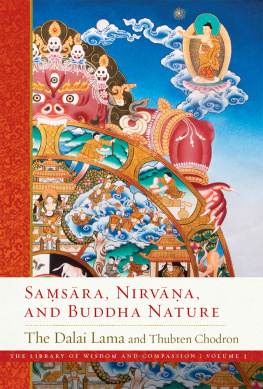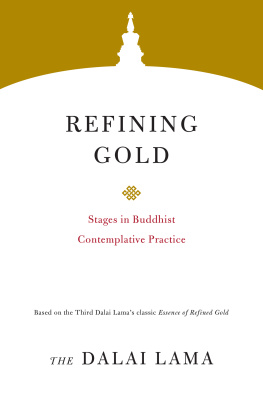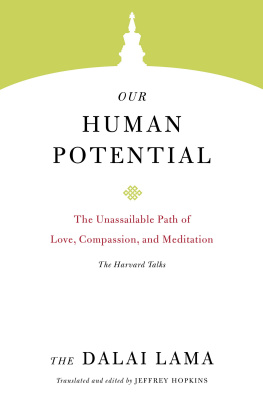PRAISE FOR
Buddhism: One Teacher, Many Traditions
Originating from a common source in the teachings of the historical Buddha, the southern Theravda tradition, based on texts in Pli, and the northern traditions of Tibet and East Asia, based largely on texts originally in Sanskrit, all developed their own unique systems of doctrine and practice. These are impressive in their philosophical insights into the nature of reality and in their understanding of the deep potentials of the human mind. In this book His Holiness the Dalai Lama and the American bhiku Thubten Chodron jointly explore the commonalities and differences among these Buddhist traditions, doing so with exceptional precision. This book will reward those who study it carefully with a deep and wide understanding of the way these traditions have mapped their respective visions of the path to enlightenment.
Bhikkhu Bodhi, translator of In the Buddhas Words

His Holiness and Thubten Chodron have collaborated to create an invaluable modern-day resource that explores, illuminates, and clarifies the commonalities, synergies, and divergences within the major historical Dharma streamsespecially regarding liberation, an analysis never before done in this way. It also shows how these profoundly ethical teachings can be skillfully applied in our present era to, in their words, serve humanity and benefit sentient beings both within the Buddhist community and beyond. It is a timely offering, at once compelling and wise.
Jon Kabat-Zinn, author of Full Catastrophe Living
Buddhism: One Teacher, Many Traditions is like a well-constructed bridge over a beautiful, deep river. People from all traditions will be able to find a clear view of both the Buddhas teachings and the vast, rich landscape those teachings have nourished. The spirit of respect and harmony expressed in this excellent book is inspiring.
Sharon Salzberg, author of Real Happiness

This is an invaluable survey of Buddhist civilizationswith their comprehensive histories, philosophical tenets, ethical disciplines, meditation trainings, and goals to be attainedall elucidated in one volume. A precious gift to all who love the Dharma.
Tulku Thondup, coauthor of Boundless Healing

Now that people around the world have unprecedented access to all traditions of Buddhism, a growing number of Buddhists find themselves drawn to theories and practices from different traditions. This makes this book especially valuable, for it presents clear and accurate comparisons between the Pli-based and Sanskrit-based schools of Buddhism, showing the common ground and significant differences in their interpretations of key themes of the Buddhist path to liberation. I highly recommend this volume for everyone seeking a more global understanding of the many traditions of Buddhism, all inspired by the one Teacher, Buddha Shakyamuni.
B. Alan Wallace, author of The Attention Revolution
BUDDHISM

Contents
T HE DALAI LAMA and I both embarked on our lifes work early. He was identified as the leader of Tibetan Buddhism as a toddler, not long before I at age twelve became a monk in the Theravda Buddhist tradition in my native Sri Lanka. Causes and conditions thus came together for each of us to begin our journeys to preserve and share the wisdom of the Buddha at around the same time.
I first met His Holiness the Dalai Lama in India in 1956 at the Buddhist holy site of Sanchi. He was visiting on one of his first trips outside his homeland, three years before he was forced to flee Tibet. We did not meet again until the 1993 Parliament of World Religions in Chicago. Even though I do not meet him very often, I continue to feel an inner connection with him because of his wisdom and fairness in sharing his Dhamma knowledge. So it is with deep appreciation and admiration of His Holinesss wisdom that I happily offer a few words at the front of this book that His Holiness and Venerable Thubten Chodron have written about our shared Buddhist tradition.
People today are generally more broadminded than those who lived before. Though the world is not without conflict, a unifying trend is emerging as we become more economically and culturally interconnected. Given this current trend, Buddhist unity is overdue. Although we Theravda Buddhists have long met with other Buddhists, once the panel or conference is over, we go our separate ways, and nothing much happens.
Well-meaning books on the various traditions show our common points but, perhaps in order to be polite, say little about the differences among us. We need not consider it impolite to point out where we differ. Not only are there doctrinal differences among the various types of Buddhists, cultural practices also differ from country to country. Even within a single country, Buddhist practices may vary from region to region or group to group. Being able to honestly survey the traditions is a healthy sign of our strength and sincerity. There is nothing to hide in the Buddhas teaching. The present work is to be commended for its honest and systematic examination of the great overlap between the Pli and Sanskrit Buddhist traditions while at the same time not shying away from discussing the many ways in which the teachings diverge.
Still, while it is healthy to discuss our differences openly, focusing on them to the exclusion of our shared heritage is also misguided. Both the Pli and Sanskrit traditions have made tremendous efforts to bring more peace to the world through the sincere preservation of the teachings of the Buddha. It is rare, in either tradition, to find any call for violence to promote one tradition over the other. Thus religious politics is completely foreign to the Buddhas teaching, but sadly some Buddhists fail to practice what their religion teaches. Enthusiasm for the real Dhamma is sometimes so strong that the very basic instruction of the Buddha on how to teach the Dhamma without creating conflict is overlooked.
On this point, the Simile of the Snake (MN 22) is quite relevant. In this sutta, wrongly grasping the Dhamma is compared to catching a poisonous snake by its tail. A snake will bite and cause death or sickness if held incorrectly, but if the snake is caught correctly, the venom can be extracted for medicine and the snake released without harm. Like this, we must grasp the meaning of Dhamma correctly and not cling to it. Mishandling or clinging to the Dhamma can poison the mind just as a venomous snake can poison the body, and poisoning the mind is much more dangerous.
If we properly grasp the meaning of Dhamma, we can experience what is called the miracle of education. Because ignorance is so strong and deep, the Buddha at first wondered whether he would be able to help people understand Dhamma in order to free them from suffering. However, he began to teach, and using his wisdom, he turned vicious persons into saints, wicked persons into holy ones, and murderers into peacemakers. This potential for transformation is the miraculous power of education.
In order to experience the miracle of education for ourselves, we must look within. The truth within us that we can experience all the time is called the Dhamma. It is this Dhamma that invites us saying, If you want to be free from trouble, look at me. Take care of me. The Dhamma within us talks to us constantly, even if we are not listening. Buddhas need not come to this world for the Dhamma to exist. The buddhas realize it and comprehend it, and having realized it, they teach it and make it known; but whether it is expounded or not, the Dhamma is there within us to be seen and heard, if we will only wipe the dust from our eyes and look at it.

